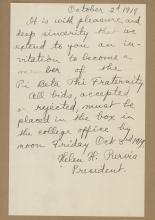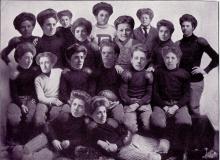Pledge Formals and the Ladies of Metzger Hall
Barbara Wishmeyer, the Dean of Women for the Academic Year 1962-1963, included photographs of her female students in her scrapbook of their pledge formal attire during the sorority rush/pledge spring season. Women had the opportunity to pledge Chi Omega, Phi Mu, Pi Beta Phi, and Zeta Tau Alpha. In these photographs from top to bottom are:
Peggy McBee
Doris Detweiler '66
Carol Frey '66
Ann Davis
Elisabeth Lane '66
Lori Shimer
Fall Panhellenic Rules 1962
From the Wishmeyer Scrapbook, this listing provides over a dozen rules and regulations for all girls rushing sororities. Things like social phone calls between upperclass women and freshman and showing any "preference between upperclassmen and freshman or rushee or unaffiliated upperclasswoman going through rush" are absolutely forbidden. In the text here, counselors must remain impartial and not support any one sorority by wearing letters or insignia or discussing certain sororities.
A Female Graduate Recalls Sorority Life in the 1960s
In one of the responses from the "Women as Leaders Survey" from 1979, a female graduate of the class of 1969 writes on her experiences with Greek Life at Dickinson. She mentions that social life at Dickinson could be restrictive in forming relationships with people because "people were stereotyped...in those years (frat vs.
"The Freshman-Sophomore Co-ed Rush"
"The Freshman-Sophomore Co-ed Rush" is a humorous piece in the 1909 Microcosm that pokes fun at the tensions between the Freshman and Sophomore classes. The fight between the two classes broke out because of a Freshman singing and playing a song about their class pride. This causes an outrage amongst the Sophomores and a fight between all the women then ensues. Freshman and Sophomore women are ripping out hairpins and combs, carrying others away and pinning them against the wall. After some time, the Dean of Women, Mrs.
Changes in Rushing Rules
According to the official minutes of Sui Generis, a non-exclusive women's fraternity, the Pan-Hellenic Council established changes to the rush rules for the subsequent semester. According to the minutes, "There will be free association in South, but no in other eating establishments, riding in cars is OK if two or more sororities are present, double dating with a Freshman and a sorority girl is OK if arranged by the boys, and only one social service project may be advertised on campus." Pan-Hel also established the length for invitational parties and what food would be served during open
Pan-Hellenic Council in 1954
In 1954, the women of the Pan-Hellenic Council continued their work toward maintaining good relations among all of the women's fraternities and supervising the rush process, which was deferred to the second semester. In the fall, they organized two Pan-Hellenic teas, which allowed freshmen women to meet upperclassmen, sponsored the annual Pan-Hellenic Weekend, and sold flowers and Parents' Day and Homecoming. The members of the Council now receive Pan-Hellenic Keys, to show their affiliation with the organization and to promote good spirit and cooperation among the women's groups. Shirle
Pan-Hellenic Council in 1952
In 1952 the Pan-Hellenic Council was lead by Phyllis M. Lamont, president, and Marjorie E. Heymann, secretary-treasurer, and was composed of two members of each of the four sororities on campus. In addition to organizing the two weeks of fall rush, Pan-Hellenic focused on organizing the all-college Doll Dance before the winter recess. To enter the Doll Dance, participants had to bring a doll to donate to the children of prisoners; attendees were entertained by skits presented by the new pledge classes.
Commuter Students
Kathryn Thomas Daugherty (Class of 1946) describes her experience as a commuter student in an interview. She chose to complete two years of study at the college before taking courses in Harrisburg to become a medical technician. Although she had planned to become a doctor, finances prevented this course of action. In order to pay for school, she worked in the library as an assistant to the librarian, shelving books and helping library users. In order to commute to Dickinson from Harrisburg everyday, she and three or four other students paid a Dickinson professor to drive them to school.








